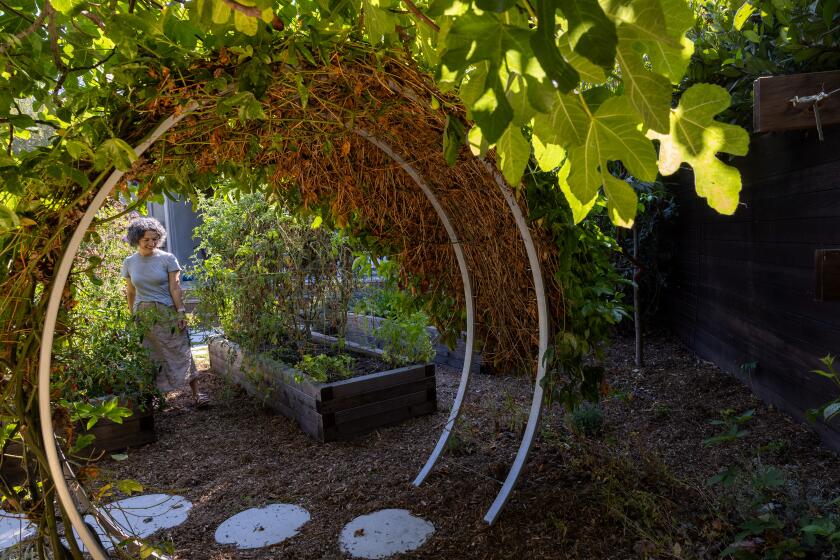Plant Thinner
For superior camellias this winter, thin out buds as well as stems now, keeping in mind that individual blooms can be three inches or more across. Make sure that the bushes have some moisture during the dry weather, and give them a camellia, or acid, fertilizer.
Thin trees now, before the Santa Anas come. Cutting windows in the canopy of a tree is like putting holes in a sail; it takes the power out of the wind. Because the winds are so drying, water trees deeply so the roots can pick up the moisture they’ll need.
Cutworms and flea beetles are very destructive to dichondra lawns. To check for cutworms, flood the area and see if they come wriggling out of the ground to the surface. To detect tiny flea beetles, place a sheet of white paper over the dichondra and tap it. If either is found, the lawn should be treated. Dichondra is shallow-rooted and should be watered twice a week. Bermuda grass, on the other hand, is very deep-rooted and can get by being watered deeply once a week.
Start bedding plants or perennials from seed. They will be ready to go in the ground in six or eight weeks. Fill a flat with house-plant or potting mix. Cover the seed to their depth and water carefully. Don’t let the soil dry out while the seeds are starting. Besides being economical, seeds give you a greater selection; you can grow plants that might not be available otherwise, like long-spurred yellow columbine or white foxglove. Unusual seed is available from Thompson & Morgan (P.O. Box 1308, Jackson, N.J. 08527) and others such as W. Atlee Burpee Co. (300 Park Ave., Warminster, Pa. 18974) and Park Seed Co. (Hwy. 254 North, Greenwood, S.C. 29647).
Prepare vegetable and flower beds. Organic matter, available by the sack in many forms at nurseries, should never be forgotten, whatever the type of soil. Generally, the most important element needed by Southern California soils is nitrogen; sulfate of ammonia, blood meal or urea will supply this. A few soils have shortages of phosphorus, potash, iron or zinc. A complete fertilizer can help in these cases. Spread the materials on top of the soil, fork it over and rake smooth, breaking up any clumps of soil. Then water it down well. Wait a day to plant.
‘Romanesco’ broccoli comes from Italy, where it has been a popular vegetable for centuries. It has a sweet, delicate flavor, milder than that of regular broccoli, and produces a head that looks like a clump of individual swirls of chartreuse-colored sea coral (those are actually the flower-head tips of individual spears that grow tightly together). Surrounded by blue-green foliage, this vegetable rivals any ornamental plant. Fall is the time to plant ‘Romanesco’ in Southland gardens. Seeds are scarce, but you can purchase them by mail from Shepherd’s Garden Seed (7389 W. Zayante Road, Felton, Calif. 95018), which specializes in European vegetables.
Snap peas have been a home-garden favorite ever since they were introduced about five years ago. At first these delightful peas, which can be eaten pod and all, and either raw or cooked, had one drawback; like old-fashioned string beans, you had to string them. Now a new stringless variety, ‘Sugar Daddy,’ is available, and it lacks the tough, stringy fiber of the original varieties. Seeds should be available for your fall garden at local nurseries, or order them from Park Seed Co. or Burpee Seed Co.






